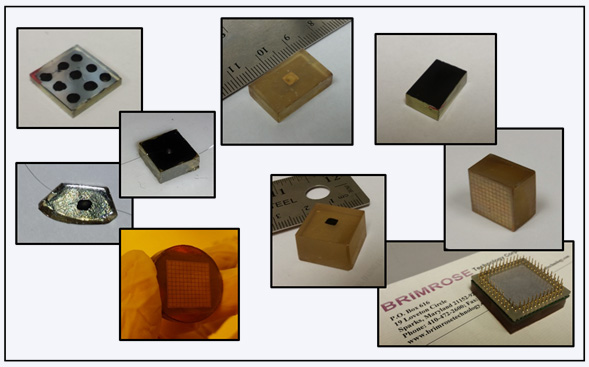Electro-Optic / Acousto-Optic Detectors
BTC uses photo-EMF and photo-refractive detector technologies. Using these technologies, Brimrose has shown significant improvement in sensitivity of acoustic sensors using pulsed laser sources. Applications include remote laser vibrometry and laser microphone.
Colloidal quantum dots technology
Colloidal quantum dots (CQDs) have dimensions on the nanometer scale and contain hundreds to thousands of atoms. CQDs that have a radius on the same size or smaller than the excitonic Bohr radius of the material will display quantum confinement phenomena. (Once they reach the size of the excitonic radius they will take on bulk properties.) In general, the larger the CQDs the smaller the band gap (the larger the cutoff wavelength). As opposed to mercury-based traditional devices, where tuning of the spectral range is accomplished by selection of the stoichiometry of the constituent atoms, CQDs are optically tuned by adjusting the size of the core grains during synthesis. MWIR response requires monodispersed CQDs with sizes in the range of 10 nm to 15 nm. LWIR response requires monodispered CQD with sizes in the range of 18 nm to 22 nm. Such a large size requires that HgTe CQDs be dissolved/dispersed in a suitable solution without settling down or precipitating out during processing to build devices.
Recent advances in narrow-band-gap CQDs have shown great promise for achieving low-power, low-cost and un-cooled SWIR, MWIR, and LWIR detection. BTC has demonstrated a CQD- based focal plane array (FPA) and camera, operating in the wavelength range of 0.9 um to 1.7 um at room temperature. CQD-based MWIR detection has been developed only at discrete single pixel level only (with some cooling).
Figure 1. TEM images of HgTe CQDs and sample absorption spectra
Brimrose Technology has extensive experience and expertise in the area of II-VI semiconductor CQD synthesis and LWIR detector fabrication using narrow-band-gap semiconductor materials. We have established facilities for CQD research and since 2006 have had two scientists working in the development of CQD materials.
Figure 2. TEM Images of HgTe QD synthesized in oleylamine (1021) and with the addition of mercaptoacetic acid (1022). Absorption spectra of the HgTe QDs (right).
For more information contact:
Dr. Witold Palosz
Brimrose Technology Corporation
410-472-7070
X-RAY DETECTION / MERCUROUS BROMIDE (Hg2Br2)
Detector Configurations
For more information contact:
Dr. Clayton Yang
Brimrose Technology Corporation
410-472-7070
Photo-EMF *
Photo-EMF sensors operate on the basis of the formation of internal electric space charge fields that are formed inside photoconductive semiconductors when they are illuminated by an optical interference pattern. The moving space charge field results in a net photocurrent output from the material even when there is no external electric field. These photocurrents can be used to deduce information about the optical frequency spectrum of the optical fields that form the interference pattern. These photo-EMF sensors, as they are called, can be used in various applications such as highly precise velocimeters and vibrometers.
Schematic of Experimental Arrangement for The PPLV for Human Life Signs Detection.
At BTC, one of our primary applications for this technology is the use of photo-EMF pulsed laser vibrometers to measure human life signs. With such a high sensitivity in surface displacement measurement and tolerance to optical speckles, the photo-EMF pulsed laser vibrometer (PPLV) is an ideal device to monitor the life signs of humans and other biological subjects.
These measurements can be taken from essentially any part of the body, with or without clothing, and without requiring any surface pre-treatments like the attachment of retroreflective tapes or deployment of specialelectronic filtering in order to eliminate the sudden dropoffs in the vibrometer output.
We have demonstrated the use of PPLV to detect the heartbeats, respirations, and gross physical movement of human subjects.
For more information contact:
Dr. Chenchia Wang
Brimrose Technology Corporation
References:
Wang, Sudhir B. Trivedi, Feng Jin, Sergei Stepanov, Zhongyang Chen, Jacob Khurgin, Ponciano Rodriguez and Narasimha Prasad. IEEE Sensors Journal, Vol. 7, No. 9 (2007) 1370.
C. C. Wang, S. B. Trivedi, F. Jin, Z. Chen, J. Khurgin, P. Rodriguez, and N. Prasad. “Biological Life Signs Detection Using High Sensitivity Pulsed Laser Vibrometer,” invited paper, CLEO, Baltimore, MD, May 2007.






